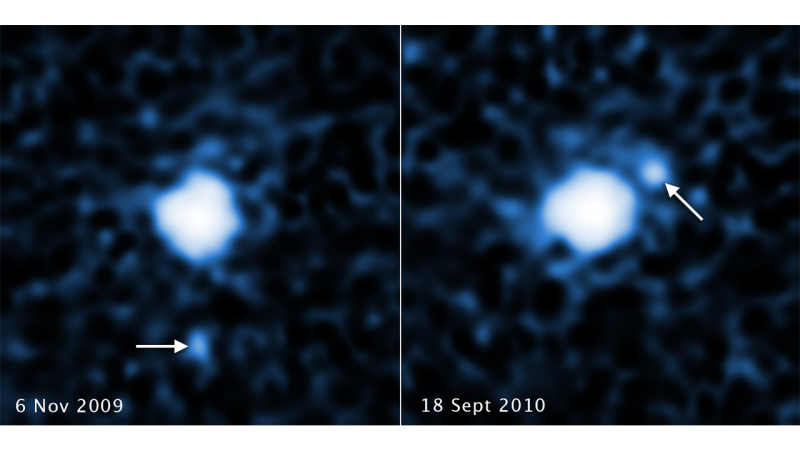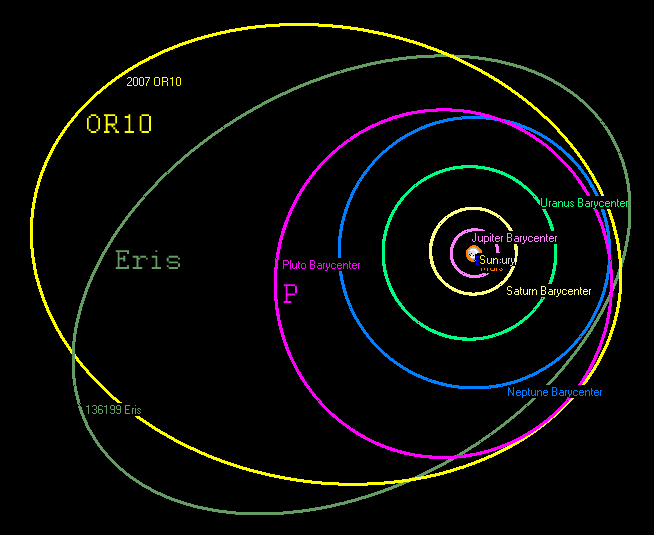
Astronomers have found a moon for the Kuiper Belt object known as 2007 OR10. This object is one of several of the uncounted icy bodies in that region of space – beyond the outermost major planet, Neptune – that has been categorized as a dwarf planet. That’s because it’s relatively big, the third-biggest dwarf planet known after Pluto and Eris. The new moon’s discovery means that most of the known dwarf planets in the Kuiper Belt larger than 600 miles (1,000 km) across have companions. Astronomers are using this discovery as a springboard for contemplating what must have been happening billions of years ago, when our sun and its planets were young. They’re thinking about how collisions between solar system bodies – which often create craters like those we see on Earth’s moon – can also create binary objects, that is, planets or dwarf planets or even asteroids with moons.
The team’s results appear in a peer-reviewed “express” journal (which lets authors publish on a shorter-than-usual timeframe), The Astrophysical Journal Letters.
Observations taken of 2007 OR10 by the famous planet-hunting Kepler Space Telescope first tipped off the astronomers of the possibility of a moon circling it. Kepler had revealed an unusually slow rotation period of 45 hours for 2007 OR10. Csaba Kiss of the Konkoly Observatory in Budapest, Hungary – lead author of the paper announcing the moon’s discovery – said:
Typical rotation periods for Kuiper Belt Objects are under 24 hours … the slower rotation period could have been caused by the gravitational tug of a moon.
The astronomers then searched for the moon in the Hubble Space Telescope’s archival images of 2007 OR10. That’s when they spotted it, in two separate Hubble observations spaced a year apart. The images show that the moon is gravitationally bound to 2007 OR10 because it moves with the dwarf planet, as seen against a background of stars.
The astronomers later calculated the diameters of both 2007 OR10 and its moon based on observations in far-infrared light by the Herschel Space Observatory. The dwarf planet is about 950 miles (1,500 km) across, and the moon is estimated to be 150 miles to 250 miles (up to about 400 km) in diameter. Earth, in contrast, is about 8 thousand miles (13 thousand km) across.


So 2007 OR10 and its moon are tiny, and they are in a remote part of our solar system, currently about three times farther than Pluto is from the sun (Pluto lies 4.67 billion miles or 7.5 billion km away). And yet the new moon is grist for the mill of astronomers who are studying our solar system. Csaba Kiss said:
The discovery of satellites around all of the known large dwarf planets — except for Sedna — means that at the time these bodies formed billions of years ago, collisions must have been more frequent. And that’s a constraint on the formation models. If there were frequent collisions, then it was quite easy to form these satellites.
The objects most likely slammed into each other more often because they inhabited a crowded region. Team member John Stansberry of the Space Telescope Science Institute said:
There must have been a fairly high density of objects, and some of them were massive bodies that were perturbing the orbits of smaller bodies. This gravitational stirring may have nudged the bodies out of their orbits and increased their relative velocities, which may have resulted in collisions.
But, these astronomers’ statement said, the speed of the colliding objects couldn’t have been too fast or too slow.
If the impact velocity was too fast, the smash-up would have created lots of debris that could have escaped from the system; too slow and the collision would have produced only an impact crater.
Collisions in the asteroid belt, for example, are destructive because objects are traveling fast when they smash together. The asteroid belt is a region of rocky debris between the orbits of Mars and the gas giant Jupiter. Jupiter’s powerful gravity speeds up the orbits of asteroids, generating violent impacts.
It’s all interesting and important to astronomers in part because they think Earth’s moon was born out of a collision with a Mars-sized object 4.4 billion years ago.
Bottom line: Astronomers have discovered a moon for the dwarf planet 2007 OR10.











